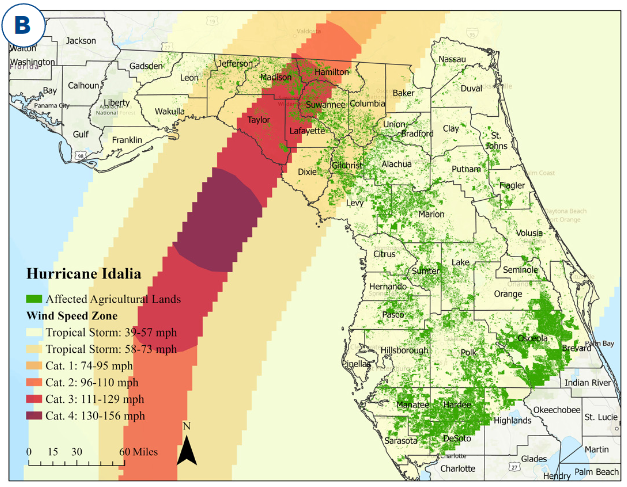Kirsten Romaguera Rabin, Public Relations Specialist, UF/IFAS Communications
Early reports from agricultural operations in Florida’s Big Bend region indicate production losses caused by Hurricane Idalia fall in an estimated range of $78.8 million to $370.9 million, according to University of Florida economists. Some 3 million acres of agricultural lands were in the storm’s path, including row crops like peanuts and cotton, dairy and poultry farms, aquaculture operations and more.

Chicken houses in Suwannee County after Hurricane Idalia. Credit: Kelly Aue, Suwannee River Partnership Outreach Coordinator
–
The UF/IFAS Economic Impact Analysis Program’s (EIAP) assessment continues, but director Christa Court, assistant professor in the food and resource economics department (FRE), said some of the most reported impacts were to infrastructure, such as overturned center pivot irrigation systems, blown-off roofs and damaged fence lines.
“Although infrastructure damage certainly affects farmers’ bottom lines and occasionally production more directly – as is the case with livestock contained in fencing or buildings, or equipment that irrigates a crop,” Court said, “we are not currently able to adequately quantify these infrastructure damages due to a lack of baseline data. However, we do believe that Idalia will help us gather critical information to build this baseline data for future assessments.”
Even with the missing baseline information, the EIAP team felt it was important to include a section about the reported infrastructure damages in its new report, “Preliminary Assessment of Agricultural Losses and Damages resulting from Hurricane Idalia.” The report is one of several resources available to federal and state agencies as decisions related to disaster declarations, response and recovery are made.

Hurricane Idalia wind swath including the Cat. 3 windspeeds (111 – 129 mph) and Florida agricultural lands with Florida counties labeled presented in panel B. Credit: NOAA NHC
For this storm, as a map to the right shows, Hurricane Idalia’s strength was concentrated in its center. The areas directly surrounding where the eye passed – portions of Dixie, Hamilton, Lafayette, Madison, Suwannee and Taylor counties – experienced Category 2- to 3-force winds; while the areas outside that center path saw a drop-off of windspeeds that maxed out at tropical-storm strength. As such, impacts to agricultural operations in the swath affected by Idalia ranged from major to almost nothing.
“Each storm brings different windspeeds and rainfall, and even though our methods allow us to estimate a credible range of losses given certain characteristics of a storm, we still rely on first-hand reports to fully understand the losses and damages caused by a particular storm,” said Xiaohui Qiao, research assistant professor in the UF/IFAS food and resource economics department and data analyst for EIAP.
To arrive at agricultural loss estimates, the EIAP uses several layers of data gathered from multiple sources. The complex process includes overlaying the storm’s path, windspeeds, rainfall and flooding with the acreage, value and seasonality of the agricultural commodities grown or raised in the counties affected by the storm. This overlay is combined with information about how different commodities are affected by particular storm conditions. Finally, the economists refine their estimates using survey responses submitted by affected agricultural producers and Florida Cooperative Extension faculty.
The commodity categories with the highest predicted losses due to Hurricane Idalia include:
- Animals and animal products, $30.1 million to $123.4 million. This includes beef and dairy cattle, poultry and shellfish aquaculture, as well as products like milk, eggs and honey.
- Field and row crops, $30.7 million to $93.6 million.
- Greenhouse and nursery products, $4.7 million to $68.8 million.
Court and her colleagues began collecting detailed baseline data to measure agricultural losses and damages resulting from tropical cyclone events in 2017. Since then, the program has continued to improve its baseline and impact databases and its methods for completing these types of analyses.
The survey for agricultural producers to report losses remains open; it is available in English and Spanish. Once a sufficient number of responses are received, the EIAP will release a final report later in the season that will include county-level estimates of production losses.
- Where Did That Weed Come From? The Importance of Weed Management Practices and Timings - December 5, 2025
- Sustainable U.S. Peanuts Kicks Off 2025 Crop Enrollment - December 5, 2025
- Grant Opportunity Available to Attend American Forage & Grassland Council Conference, Ashville – January 12-15 - December 5, 2025
